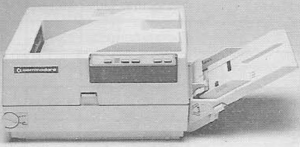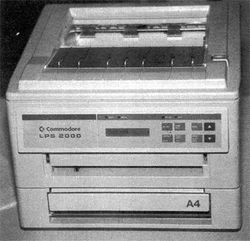Laser Printer

Laser Printers produce texts and images by electrostatically charging a roller. This charge causes the fine toner powder (black or one colour) to stick to the roller and can be transferred to the paper in the next step. In the case of a colour printer, the four basic colours are transferred to the paper one after the other in this way.
The toner is then fixed at high temperatures with the help of a so-called fuser roller and melted onto the paper.
In the past, laser printers were mainly used in companies, as they were extremely expensive to buy. Colour laser printers cost more than DM 5,000 in the 1980s, black and white devices were considerably cheaper.
Nowadays, many computer companies produce (color) laser printers, and Xerox and Hewlett Packard have been part of this from the beginning. The first laser printer was the HP Laserjet in the mid 1980s.
From the manufacturer Commodore there were only two black and white laser printers, the LP 806 (1988) and the LPS 2000 (1991). But for the home computer of Commodore numerous compatible devices from other manufacturers appeared.
There were only a few C64-programs that supported (laser) color printers:
Advantages[edit | edit source]

- Flexible printing of text and graphic.
- Processes many types of paper, from plain paper to specialty papers.
- High durability of printouts (comparable to or even better than a photocopier) - also they are document-proof.
- Very high print resolution (today up to 5,000 dpi).
- Rewards for many printouts.
- High speed (formerly 6 pages/minute, today 20 pages/minute or more possible).
- Lower volume than the daisy-wheel printer or dot-matrix printer which were very common in the past.
- Toner cartridge lasts for over 1,000 to 5,000 prints (depending on whether only text or graphics are printed).
Disadvantages[edit | edit source]
- Formerly high acquisition costs, also for toner powder (but lasts for several 1,000 pages!).
- Regular maintenance required (e.g. after 3,000 prints or in annual intervals, even this is rarely necessary nowadays).
- Regular replacement of the fuser roller necessary (e.g. after 10,000 prints or 5 years).
- Not all papers or foils can be printed, because the fusing takes place at high temperatures (200°).
- No carbon copies possible.
- Previously mostly only usable on certain computer systems; e.g. Apple or IBM-PC.
- In older models ozone is produced due to the way the charge is transferred, which can be harmful to health in higher quantities!
- The toner powder is harmful to health. Fine dust particles can irritate or damage the respiratory tract and the skin, so use laser printers only in well-ventilated places and wash or clean up spilled toner powder with cold water!
Links[edit | edit source]
| Wikipedia: Laser_Printing |